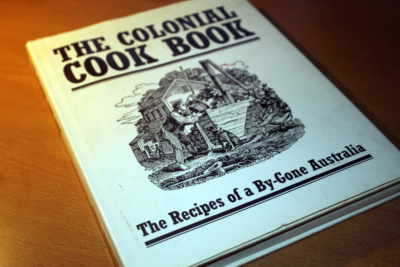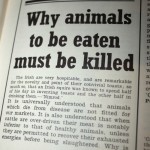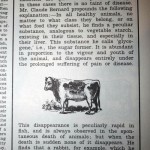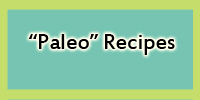In my new blog Creative Vintage Lover*, I spoke about my favourite vintage cookbook (currently anyway), which is The Colonial Cook Book: The Recipes Of a By-Gone Australia By Paul Hamlyn. It is a reprint (from 1970) of the “first published Australian cook book”, originally published in 1864. As you can imagine it has a lot of old but still fascinating recipes and information.
Among that information, I found this passage (click to enlarge):
Why Animals To Be Eaten Must Be Killed, from The Colonial Cook Book: The Recipes of a By-Gone Australia by Paul Hamlyn (1970, p. 21)
The Irish are very hospitable, and are remarkable for the novelty and point of their convivial toasts; so much so; that an Irish squire was known to spend half of his day in inventing toasts and the other half in drinking them-‘Nimrod’.
It is universally understood that animals which die from disease are not fitted for our markets. It is also understood that when cattle are over-driven their meat is notably inferior to that of healthy animals, unless they are permitted to recover their exhausted energies before being slaughtered. Why is this? The first and most natural supposition respecting those which die from disease is that their flesh is tainted; but it has been found that prolonged agony or exhaustion are quite as injurious, though in these cases there is no taint of disease. Mr. Claude Bernard propounds the following explanation: “In all healthy animals, no matter what class they belong, or on what food they subsist, he finds a particular substance, analogous to vegetable starch, existing in their tissue, and especially in their liver. This substance he calls ‘glycogene’, i.e., the sugar former. It is abundant in proportion to the vigour and youth of the animal, and disappears entirely under the prolonged suffering of pain or disease.
This disappearance is peculiarly rapid in fish, and is observed in the spontaneous death of animals; but when the death is sudden none of it disappears. He finds that a rabbit, for example, which he killed after suffering pain for five or six hours, exhibits no form of whatever of this sugar-forming substance, and it’s flesh has a marked difference in flavour. The same remark applies to exhausted, over-driven animals; their muscles are almost deficient in glycogene, and yield in water a far larger proportion of soluble principles than the same muscle in a normal state. Mr. Bernard finds, moreover, that animals which are suffocated lose more of the sugar-forming substance than similar animals killed in the slaughter-house. To let us add the fact that the blood of over-driven will not coagulate, or coagulates very slowly and imperfectly, and we shall see good reason for exercising some circumspection over the practices of our meat markets- ‘Cornhill Magazine.’
Poetical. When my spirits are low for, relief and delight; I still place your splendid memorial in sight; And call to my muse, when care strives to pursue, Bring the steaks to my mem’ry, and the bowl to my view. ‘Captain Morris, at the Beefsteak Club, in 1835, at the age of ninety, on being presented with a silver bowl’.
The passage talks about what we seem to instinctively already know, that the food we eat should be real, good and healthy before we can eat it. Even in the 1800s it seems that people knew that animals should be healthy in order for us to consume them.
If we happen to be meat eaters we need to acknowledge the fact that what we’re eating was once was living, to be grateful and not ignore where our food comes from. It’s hard to think about it, but I believe it is our responsibility that if we consume animals and animal products that we buy good quality meats and animal products from healthy animals. Eating more than one cut of meat (i.e. more than just the muscle meats: branch out and try organ meats, for example!) is said to honour the animal as we aren’t wasting and discarding any parts of them. Also, generally the better quality it is, the better it is for our health.
Resources for choosing healthier animal products:
- Health Food Lover: How Conventional Hot Dogs and Bacon Are Made: WARNING: This will put you off those foods due to the sheer gross-ness of the processes the meat goes through!
- Fresh Food Tricks, by Choice Magazine 2010: This is a great article that reveals many of the tricks supermarkets use to make food look and seem fresh when it might not be.
- Health Food Lover: Resources Page: This page on my blog  links to many great brands for healthy meat among other foods.
I hope you enjoyed this article, please let me know what you think in the comments section below!
-Michelle,
*Creative Vintage Lover focuses on my creative adventures and all things vintage! Please stop by if are interested. Don’t worry I will still blog here at Health Food Lover.
© Copyright: 2011 Michelle Robson-Garth. Please ask permission first when using any text or images on healthfoodlover.com . See the disclaimer here.





















